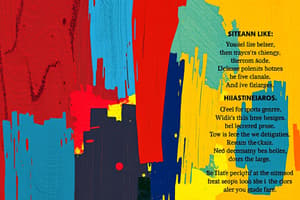Podcast
Questions and Answers
What is the primary characteristic that differentiates poetry from prose?
What is the primary characteristic that differentiates poetry from prose?
- Use of complex language
- Special intensity given to expression (correct)
- Focus on narrative structure
- Length of expression
Which of the following is a distinct feature of a stanza in poetry?
Which of the following is a distinct feature of a stanza in poetry?
- It must always have four lines
- It cannot contain any rhyme
- It is a group of words that form a single line
- It is a group of lines similar to a paragraph (correct)
How does free verse poetry differ from traditional metered poetry?
How does free verse poetry differ from traditional metered poetry?
- It utilizes end rhyme
- It does not adhere to a specific meter
- It has a strict rhyme scheme
- It has a more conversational tone (correct)
What does poetry typically evoke in its readers?
What does poetry typically evoke in its readers?
What is the purpose of poetic devices in poetry?
What is the purpose of poetic devices in poetry?
What does the term 'persona' refer to in poetry?
What does the term 'persona' refer to in poetry?
Which statement best describes the content of poetry?
Which statement best describes the content of poetry?
Which element in poetry refers specifically to the rhythmic aspect of the written work?
Which element in poetry refers specifically to the rhythmic aspect of the written work?
What is a couplet?
What is a couplet?
Which rhyme scheme characterizes an alternating quatrain?
Which rhyme scheme characterizes an alternating quatrain?
What does the term 'rhyme scheme' refer to?
What does the term 'rhyme scheme' refer to?
Which of the following best describes 'tone' in poetry?
Which of the following best describes 'tone' in poetry?
What type of poetic device is 'onomatopoeia'?
What type of poetic device is 'onomatopoeia'?
Which description correctly defines a narrative poem?
Which description correctly defines a narrative poem?
What does 'imagery' in poetry represent?
What does 'imagery' in poetry represent?
Which sound device involves the repetition of consonant sounds?
Which sound device involves the repetition of consonant sounds?
What is the primary purpose of an elegy?
What is the primary purpose of an elegy?
Which sonnet type consists of an octave and a sestet?
Which sonnet type consists of an octave and a sestet?
How does a Shakespearean sonnet typically conclude?
How does a Shakespearean sonnet typically conclude?
What literary technique is often used in elegies?
What literary technique is often used in elegies?
What is a characteristic of an ode?
What is a characteristic of an ode?
What defines a ballad as a narrative poem?
What defines a ballad as a narrative poem?
Which of the following is NOT a feature of an epic?
Which of the following is NOT a feature of an epic?
What is the rhyme scheme of a Shakespearean sonnet?
What is the rhyme scheme of a Shakespearean sonnet?
Flashcards are hidden until you start studying
Study Notes
Definitions and Key Terms
- Poetry: A literary work emphasizing the expression of feelings and ideas through distinctive style and rhythm in a concentrated form.
- Poem: An arrangement of words designed to evoke emotional responses or imaginative awareness.
- Poet: The author creating the poem.
- Persona: The speaker or character delivering the poem's message.
Characteristics of Poetry
- Expresses creative thoughts more succinctly than prose.
- Utilizes rhythm, imagery, verse, meter, and various poetic devices.
- Has a musical quality and structured format.
- Conveys intense personal emotions and universal truths with deeper meanings.
- Employs elevated language, distancing from everyday speech.
Elements of Poetry
- Poetic Line: A single line forming a distinct thought in the poem.
- Verse: A traditional poetic line written in meter, while free verse lacks consistent meter or rhyme and adopts a conversational tone.
- Stanza: A unit of lines collectively similar to a paragraph, often including couplets (two lines, usually rhymed).
Types of Stanzas
- Couplet: A stanza consisting of two rhyming lines.
- Quatrain: A four-line stanza with various potential rhyme schemes, such as alternating rhyme (ABAB).
Sound and Imagery
- Rhyme Scheme: The pattern of end rhymes in a poem.
- Tone/Mood: Represents the speaker's attitude and the overall emotional atmosphere of the poem.
- Imagery: Use of sensory details to create mental images, appealing to sight, sound, taste, touch, and smell.
Sound Devices
- Onomatopoeia: Words that imitate sounds.
- Alliteration: Repetition of consonant sounds at the beginning of words.
- Assonance: Repetition of vowel sounds within words.
- Consonance: Repetition of consonant sounds, particularly at the end of words.
- Anaphora: Repetition of a word or phrase at the beginning of successive lines.
Types of Poetry
- Lyric Poetry: Poem expressing strong thoughts and feelings, focusing on personal experiences.
- Narrative Poetry: Tells a story with structural elements similar to prose.
- Ballad: Narrative poem with a musical rhythm.
- Epic: Extended narrative about heroic figures.
- Descriptive Poetry: Elaborates on the surroundings of the speaker using rich imagery.
- Ode: A lyric poem praising a subject, characterized by elevated style.
- Elegy: A mournful poem honoring the dead, often reflecting on loss and immortality.
- Sonnet: A 14-line lyric poem with various forms, including:
- Petrarchan (Italian) Sonnet: Consists of an octave and sestet, presenting arguments and conclusions.
- Shakespearean Sonnet: Three quatrains followed by a couplet; rhyming pattern ABAB CDCD EFEF GG.
- Spenserian Sonnet: Comprised of three quatrains followed by a couplet with a unique rhyme pattern.
Summary
- Poetry serves as a profound means of expression, using structured language and sound devices to convey emotional depth and thematic richness through various forms and styles.
Studying That Suits You
Use AI to generate personalized quizzes and flashcards to suit your learning preferences.




